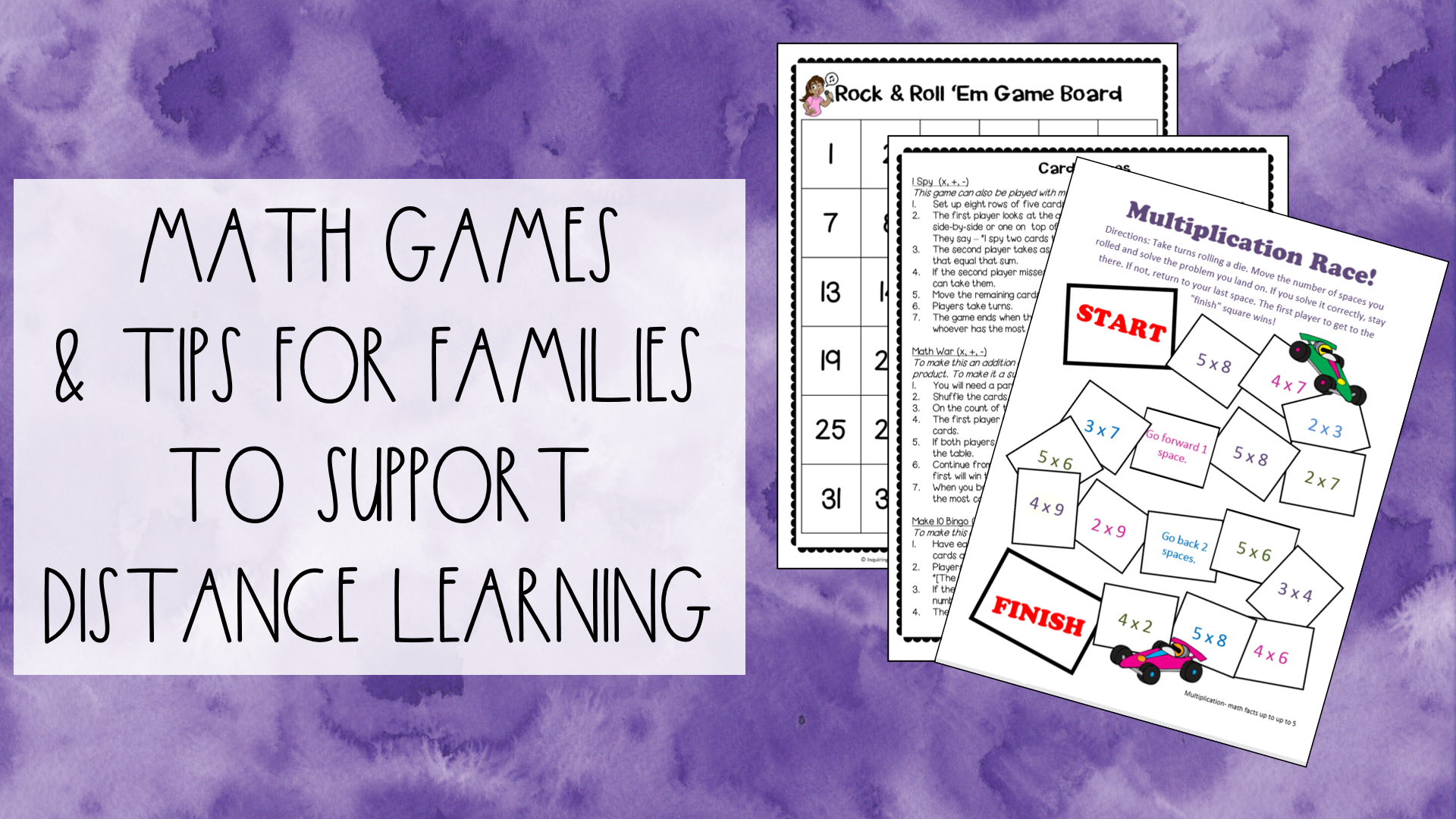If you’re anything like me, your eyes start to glaze over when you’ve been looking at a screen for too long. This online learning business is not what I signed up for! It’s not what my students and their families signed up for either. The longer I spent teaching online, the more I realized just how much screen time my students were getting between school assignments and leisure activities. I started to challenge myself to find ways to find ideas for online class activities that didn’t actually require the kids to be online or stare at a screen.
Related Posts: How I Structured Online Class Meetings for my Fifth Grade Class
Games for Online Class Meetings in Upper Elementary
Math
Math Hunts
Send students off to find real-world examples of the math concepts you are learning about. Exploring about decimals? They can photograph one and a half pairs of socks (see my example below) or 0.75 of an apple. Learning about area and perimeter? They can measure the area of their bedroom, draw it out, and calculate the measurements. Leave things as open-ended as possible. Students will only need to look at screens while reading the instructions and uploading their work.
Math Games
Paper math games are a fun way for students to practice their math facts with no screen time at all. Before we went online last Spring, I sent all of my students these games and included this booklet of simple math games and handy tips for students who needed extra practice. Encourage students to invite people in their homes to play with them but let them know that if family members are unavailable, they can play against themselves too. Younger students might enjoy playing with (aka, on behalf of) a pet or stuffed animal. If students are able to play with parents or guardians, these math games give the adults in their lives an opportunity to see what the child knows and where they struggle.
Before sending the games home last year, I sent an email to my students’ families asking if they needed dice. For those that did, I just dropped one in their pencil cases while we packed up their supplies. I already had a bunch of these dice-in-dice, so each student only needed one even when the games required two (that’s one less thing to lose!). Most families were able to use dice from games they already had. You can also email families this paper-dice template.
Equivalent Fraction Recipes
To make either of these two recipes, students have to convert all the fractions into quarter cups and half-teaspoons. What a delicious way to put what they’d been learning about fractions to the test! Since many students will be baking with adults anyway, consider sending answer keys to parents and guardians or posting them in another spot in your online classroom so kids can check their work before they bake. Consider individual diets, allergies, religious holidays that might require fasting, and socioeconomic factors before making this a must-do task; I made it an extension activity.
Making 3D Shapes
Building paper versions of 3D shapes is a screen-free way for students to develop hands-on understanding of how the shapes work. There are free printable versions here. If you do not want to be assigning work that requires printing (ink is expensive and not all families have printers), challenge students to make their own nets for 3D shapes, photograph them, and then photograph the final products once they have cut them out and put them together!
Build a Game
Challenge students to design their very own game and calculate the probability of a particular number of outcomes. This could be a board game or something more like a casino game (we’ll call it an arcade game to make it kid-friendly…). Naturally, students may not have all the same art supplies that they have at school, so remind them that the appearance isn’t what you’re assessing. With the exception of a final video where they explain their creation and the calculations, there is very little screen time required for this assignment. You can combine this with a persuasive writing unit by having students create print and/or video advertisements about their games!
Marth
You read that right, I said “marth”! Combing math and art is a perfect way to make math fun and get kids thinking creatively. There are tons of amazing math and art projects online. One quick and easy math assignment that requires no screen time would be a transformations project. Here is my example below!
English
Podcasts
Podcasts are a great way to have kids practice their listening skills and make a text accessible to all your learners (auditory texts are texts too!). Just make sure you find a podcast that has a transcription or that you transcribe if yourself if you have students who are deaf and hard of hearing or students with auditory processing disorders. Kids don’t have to actually look at their screens when they listen to these podcasts. You can give them an activity to do after, like a quick Microsoft Form or discussion post, or activities like doodle notes to do while listening and upload when they’re done. If you’re looking to dabble in podcasts a bit, consider assigning one of these Secret Life of Canada Shout Outs! They’re super short and most of them are totally kid-appropriate (do check first to make sure they are well-suited to the level you are teaching). I also have this free podcast response sheet for the shout outs that focus on Canadian activists; there is a fillable PDF version included specifically for distance learning.
Stand-up Comedy and/or Personal Storytelling
I’ll admit that last year was the first time I’d done a proper oral language unit, and now I’ll never go back! I’ve always been turned off by the stuffiness of a speeches unit, but I really enjoyed our oral language unit once I reworked it to have a stand-up comedy/personal storytelling focus. This unit did require some screen time because kids had to watch some stand-up videos. However, quite a few assignments were completely screen-free because they had to prepare and practice telling their stories aloud. This unit worked really well in our online classroom format. I hope to write a separate blog post about it soon in case you are interested in adapting it for your own students!
Dragon’s Den/Shark Tank Pitches
Get students using their persuasive writing and oral language skills by having them create and film a Dragon’s Den or Shark Tank pitch for an item they have in their home. You can also bring in STEM by asking students to create the item that they pitch! To reduce screen time and to mimic the ‘live’ pitching on the shows, tell students they are not to edit their videos and that you would like them to do them in one take. It’s a little like a speech, but a lot more fun! Some screen time will be required for uploading, and you may want to link a few sample videos to give students an idea of what you are looking for. You can make this process even more engaging by having students post their videos to small groups in the online classroom and having group members pose as ‘Dragons’ or ‘Sharks’ that ask questions in the comments!
Read Aloud Virtual Library
Have students pick a picture book they love (preferably a paper copy of one they have at home, but a digital copy would work too) and film themselves reading it. Before taking the video, they should practice reading the book with good inflection and look for opportunities to ask questions of their ‘audience’ to encourage inference-making. Now you can assess their oral language skills and their metacognition! If possible, have students post these videos in a section of your online classroom so all their classmates can see it. Alternatively, you could break them into small groups. Require each student to watch at least one other video and answer the questions that the reader poses to the audience. The last part of this assignment does require some screen time, but the first part requires virtually none! This can get tricky with copyright issues, so make sure the videos are stored in a password-protected classroom and not posted elsewhere. I would encourage you to share a list of publishers who have allowed for digital read alouds during the pandemic so your students know what their options are!
A twist on this assignment would be to have students do creative story-writing a few times a week and regularly record themselves reading what they have written. Posting it in the online classroom will allow others to hear stories their peers have written. You can even use this as a way to do peer feedback! It’s OK if a student isn’t finished a story in time for their recording; it will just be like an old-fashioned radio show where listeners have to tune in again next week! I would suggest putting a time limit on the recordings, so listeners aren’t deterred by super-long posts. Consider staggering students’ assigned posting dates so there is always new content to listen to and so you don’t get back-logged with marking!
Family/Community Interviews or Story Sessions
Have students interview someone they know well or ask them to share a story from their own life. Students can then summarize that story and share it with the class or teacher. Possible formats include graphic novels or comic strips, oral retellings, infographics, timelines, or just rewriting the story in their own words using selected quotes as necessary (consider whether you want this to be a screen-free activity or not when giving options). I would encourage you to let your students pick their format and whether they want this assignment shared with the whole class or just the teacher(s) and support staff.
Independent Reading!
Last but not least, let them read! When my students and I are in school, I protect their independent reading time at all costs. When we went online last Spring, I found that putting a note about daily reading in my weekly schedule was not an effective way to actually get them reading. Next year, I will be listing it as an assignment that they are to ‘work’ on each day. I don’t care what they’re reading; it can be Captain Underpants or The New York Times. I just want something they enjoy and are able to read independently! I am going to assign a weekly update where students will be asked to share what they read/are reading, what they think of it, and perhaps answer one or two more specific questions. I don’t want to make reading seem like work, but I want to remind them that reading is expected. The only screen time for this assignment would be the weekly update.
STEM and Art
Nature Art
Challenge students to go outside, make art from what they find (acorns, flowers, etc.), photograph it, and upload the picture to your virtual classroom. Getting them outdoors, creating zero-waste art, and encouraging creative thinking in one activity? Yes please! If “make art” is too generic for you, you can use prompts like “make something beautiful” or “make an animal” … the possibilities are endless! I love @mindheartsandarts; idea about finding Nature Dancers and can think of so many ways that could be integrated into other projects!
Sketchbooks
Have students keep a sketchbook and upload photos of some of their creations once a week. You can let them create freely, or you can give prompts to provide some guidance. To limit the number of times they need to log on and check the prompts, consider using a schedule like the one outlined below:
- Monday: Draw a place where you feel happy.
- Wednesday: Use a different medium (ex. paints, pastels) or style (ex. cartoon, pointillism) to draw the place you drew on Monday.
- Friday: Free sketchbook time
If you’re ever looking for sketchbook inspiration, @artwithmrs.e has several posts and a story highlight detailing how she uses them in her classroom!
Toilet Paper Roll Stem
STEM challenges can be a bit tricky when you don’t know what your students have at home, so keep it simple with something everyone has: toilet paper rolls! Ask families to save their toilet paper rolls for a few weeks. Then have students use them for all kinds of STEM projects like marble runs and towers. In addition to being something that all students will have in their homes, toilet paper rolls make for good at-home STEM projects because they don’t take up much storage space and don’t require students to photograph large sections of their homes. Not all families will be comfortable with others seeing into their living spaces.
Do you have any other ideas for distance learning assignments with limited screen time? If so, post them in the comments below; I’d love to hear them!




